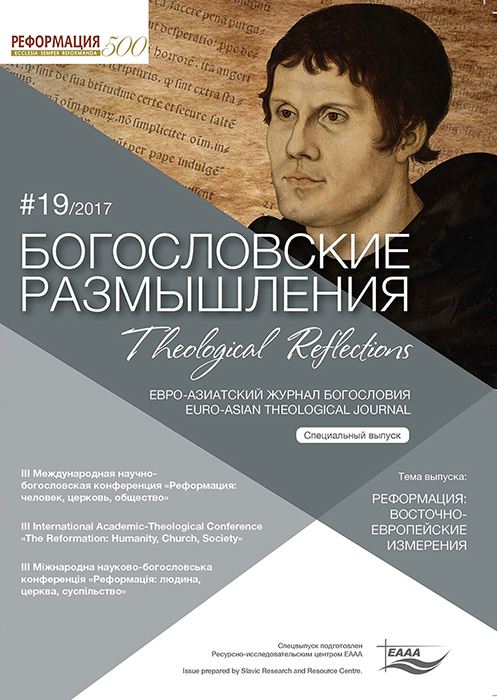Reflection of Sola Scriptura in the Classical and Radical Reformation: Western European and Eastern European Contexts
DOI:
https://doi.org/10.29357/issn.2521-179X.2017.19.24Keywords:
Protestantism, Reformation, Hermeneutics, Sola Scriptura, Epistemology, Congregational hermeneutics, Historical-critical approach.Abstract
The article examines the need for Sola Scriptura at the first stage of the reformation movement as the main tool for solving epistemological problems in order to find a reliable source of knowledge of God, bypassing the mediating role of the Catholic Church. Then the reformers tried to apply this principle to the practice, they faced the hermeneutical difficulties and the article shows the ways how they are solving these problems. Author demonstrated how the representatives of the Magisterial Reformation (the Lutheranism, Calvinism and others) limited hermeneutical highhandedness with the introduction of catechisms and confessions of faith, and representatives of the Radical Reformation (Anabaptists, Mennonites, etc.) mainly used the principle of congregational hermeneutics and hermeneutics of obedience.
In the Eastern European context, the idea of Sola Scriptura appeared several centuries later and was widely spread in the movements of religious dissidence, and later in various groups of evangelical Christianity. The use of the Sola Scriptura’ principle in these groups for a long time was based on the “common sense” approach, preserving the Anabaptist hermeneutic trajectory of naive realism, obedience and congregational control. At the early 90’s of the XX century, after the arrival in this part of the world of the historicalcritical approach, which gained popularity in evangelical schools, the principle of Sola Scriptura became more a slogan than a real program of actions. The article raises questions about the search for new hermeneutical strategy of biblical interpretation, which returns the researcher directly to the text, rather than to historical and cultural reconstructions.
References
- REFERENCES
- Estep, W.R. The Anabaptist Story: An Introduction to SixteenthCentury Anabaptism. Grand Rapids, 1996.
- Luther, M. O svobode khristianina, Sost. I. Fokin. ARS, 2013.
- Liuteranstvo. llyustrirovannyi entsiklopedicheskii slovar F. A. Brokgauza i I. A. Yefrona. v 16ti t. M.: Eksmo, 2008.
- Marshall, I. Howard. “Evangelical New Testament interpretation within the contemporary scene.” European Journal of Theology, 20.1, 2011.
- McGrath A. (1994) Bogoslovskaia mysl Reformatsii [Reformation Thought: An Introduction] Bogomyslie. Odessa, Meadors, G.T. (ed.) Four Views on Moving Beyond the Bible to Theology. Grand Rapids: Zondervan, 2009.
- Negrov, A. “Germenevtika v protsesse preobrazovaniia: tri germenevticheskikh gorizonta slavianskogo evangelicheskogo soobshchestva v postsovetskii period.” Bogoslovskie razmyshleniia. No. 4, 2003.
- Osborn, G. Germenevticheskaia spiral: obshchee vvedenie v bibleiskoe tolkovanie [The Hermeneutical Spiral: A Comprehensive Introduction to Biblical Interpretation] Odessa: EAAA, 2009.
- Pelikan, Jar. Khristianskaia traditsiia. Istoriia razvitiia veroucheniia. [The Christian Tradition: A History of the Development of Doctrine] Vol.1. 2009
- Puzynin, A. “Traditsiia evangelskikh khristian: rekonstruktsiia praktiki bibleiskogo tolkovaniia.” Bogoslovskie razmyshleniia, No.13, 2012.
- Walton, J. “Bogodukhnovennaia subektivnost i germenevticheskaia obektivnost.” Blagomyslie, No.1, 2010.
- Williams, Stuart Murray. “Anabaptist Hermeneutics: A Summary.” Retrieved from: http://www.anabaptistnetwork.com/node/247.
- СПИСОК ЛИТЕРАТУРЫ
- Estep, William Roscoe. The Anabaptist Story: An Introduction to SixteenthCentury Anabaptism. Grand Rapids, 1996.
- Marshall, I. Howard. “Evangelical New Testament Interpretation within the Contemporary Scene.” European Journal of Theology, No. 20.1, 2011.
- Meadors, G.T. (ed.). Four Views on Moving Beyond the Bible to Theology. Grand Rapids: Zondervan, 2009.
- Williams, Stuart Murray. “Anabaptist Hermeneutics: A Summary.” Режим доступа http://www.anabaptistnetwork.com/node/247.
- Лютер, М. О свободе христианина. Сост. И. Фокина. АРС, 2013.
- Лютеранство. Иллюстрированный энциклопедический словарь Ф. А. Брокгауза и И. А. Ефрона. в 16ти т. М.: Эксмо, 2008.
- Маграт, А. Богословская мысль реформации. Одесса: Богомыслие, 1994.
- Негров, А. “Герменевтика в процессе преобразования: три герменевтических горизонта славянского евангелического сообщества в постсоветский период.” Богословские размышления. №4, 2003.
- Осборн, Г. Герменевтическая спираль: общее введение в библейское толкование, Пер. с англ. Одесса: ЕААА, 2009.
- Пеликан, Я. “Христианская традиция.” История развития вероучения. Т. 1. 2009.
- Пузынин, А. “Традиция евангельских христиан: реконструкция практики библейского толкования.” Богословские размышления. № 13, 2012.
- Уолтон, Дж. “Богодухновенная субъективность и герменевтическая объективность.” Благомыслие. №1, 2010.
Downloads
Published
How to Cite
Issue
Section
License
Copyright (c) 2020 Sergiy Sannіkov

This work is licensed under a Creative Commons Attribution-NonCommercial 4.0 International License.
All articles published in the Journal are distributed under a Creative Commons Attribution-NonCommercial 4.0 International License
By submitting an article for publication in Theological Reflections: Eastern European Journal of Theology the author grants the editors the right to publish the article and distribute it in electronic and print form.
The author reserves all copyrights and the right to use the materials of the article in whole or in part for educational purposes, to write his own dissertations, to prepare abstracts, conference reports, oral presentations, etc., as well as post electronic copies of articles (including the final electronic version downloaded from the journal’s official website) on non-commercial web-resources without the consent of the editorial board and founders.



